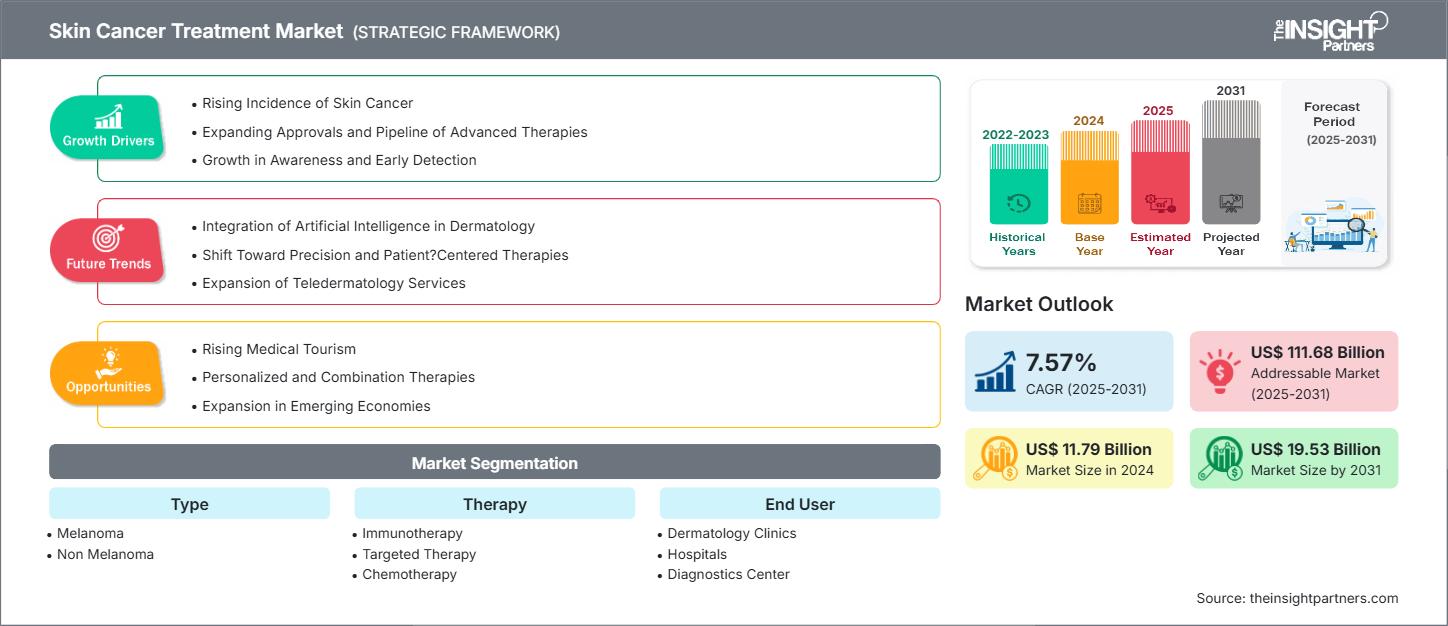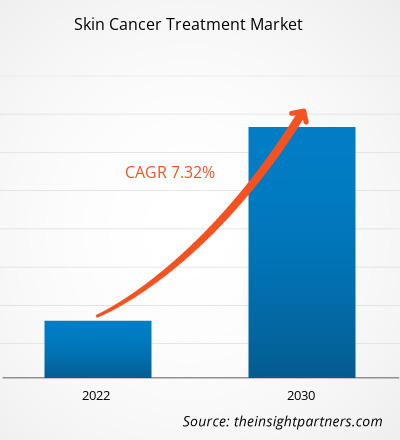皮膚がん治療市場規模は、2024年の117億9,000万米ドルから2031年には195億3,000万米ドルに達すると予測されています。市場は2025年から 2031年の間に7.57%のCAGRを記録すると予想されています。
皮膚がん治療市場分析
皮膚がんの罹患率の急増、先進治療法の承認件数の増加、そして充実したパイプラインは、皮膚がん治療の普及を促進しています。米国がん協会によると、2025年には米国で約21万2,200件の新規メラノーマ症例が発生し、そのうち10万7,240件は上皮内腫瘍、10万4,960件は浸潤腫瘍で、メラノーマは5番目に多いがん種となっています。メラノーマなどの皮膚がんの罹患率の増加は、チェックポイント阻害剤などの先進治療法の需要を生み出しています。さらに、個別化治療や併用療法の導入は、皮膚がん治療市場にとって大きなビジネスチャンスをもたらします。
皮膚がん治療市場の概要
北米は皮膚がん治療市場で最大のシェアを占めると予測されており、アジア太平洋地域は大幅なCAGRを記録すると予想されています。を記録すると見込まれています。この地域には、中国、日本、インド、韓国、オーストラリア、そしてより広範なアジア太平洋地域といった主要市場が含まれており、この地域の成長において大きなシェアを占めています。一部のアジア諸国では、皮膚がんの発生率が欧米諸国よりも低くなっていますが、これは人口のメラニン組成が優れていることが原因と考えられます。中国国立がんセンターの2024年報告書によると、基底細胞がんと扁平上皮がんの発生率は、特に福建省や広東省などの沿岸部で増加しています。
オーストラリア保健福祉研究所(AIHW )は、2023年に110万人以上のオーストラリア人がメディケア給付スケジュール(MBS)に基づいて非黒色腫皮膚がんの治療を受けたと報告しています。皮膚がんの治療を受けました。同報告書によると、2022年には黒色腫による新規症例が約1万5000件、死亡者数は1300人以上に上るとされています。
国立がん研究センターの報告によると、日本ではメラノーマの症例が着実に増加しており、特に高齢者層で増加傾向にあります。2024年のがん登録の最新データによると、皮膚がんは日本で発症率上位20位のがんの一つであり、特に60歳以上の男性で発症率が増加傾向にあります。
このレポートの一部、国レベルの分析、Excelデータパックなど、あらゆるレポートを無料でカスタマイズできます。また、スタートアップや大学向けのお得なオファーや割引もご利用いただけます。
皮膚がん治療市場:戦略的洞察

-
このレポートの主要な市場動向を入手してください。この無料サンプルには、市場動向から見積もりや予測に至るまでのデータ分析が含まれます。
皮膚がん治療市場の推進要因と機会
市場の推進要因:
-
先進治療の承認とパイプラインの拡大:
新しい免疫療法や標的療法の選択肢を含む先進的治療法の承認の拡大と強力なパイプラインにより、進行性または悪性皮膚がんの患者により多くの選択肢が提供されます。 -
皮膚がんの罹患率の上昇:
メラノーマおよび非メラノーマ皮膚がんの症例数の増加は、皮膚がん治療市場の成長を牽引しています。この皮膚がん症例の着実な増加は、市場の成長と多様化を牽引する主要な要因の一つとなりつつあります。 -
早期発見に関する意識の高まり:
皮膚がん、特に悪性黒色腫は、早期発見すれば治療効果が高いといえます。早期発見により、外科的切除など、より侵襲性が低く効果的な治療が可能になります。
市場機会:
-
新興経済国での拡大:アジア太平洋、ラテンアメリカ、アフリカのいくつかの国では、皮膚がんの症例数の増加と早期発見に対する意識の高まりにより、皮膚がん治療市場に成長の機会が生まれています。
。 -
医療ツーリズムの拡大:
中国、インド、インドネシア、ブラジル、メキシコなどの発展途上国では医療ツーリズムが増加しており、米国やヨーロッパ諸国よりも 50 ~ 70% 安い価格で高度な医療やケアが受けられるようになっています。 -
個別化療法と併用療法:
公的医療制度の下で資金提供される術前免疫療法などの先進的治療法は、高リスク患者の生存率を劇的に改善することができます。
皮膚がん治療市場レポートのセグメンテーション分析
皮膚がん治療市場は、その仕組み、成長の可能性、そして最新のトレンドをより明確に把握するために、様々なセグメントに分割されています。以下は、ほとんどの業界レポートで使用されている標準的なセグメンテーション手法です。
タイプ別:
-
黒色腫:
メラノーマは、種類別で2番目に大きなセグメントであり、世界中でメラノーマの発生率が増加していることが主な要因です。WHOは2022年に、世界中で毎年約33万人が新たにメラノーマ皮膚がんを発症していると報告しました。 -
非黒色腫:
非黒色腫皮膚がんは、黒色腫皮膚がんよりも多く見られます。非黒色腫には、メルケル細胞がん、基底細胞がん、扁平上皮がんが含まれます。これらは手術で完全に治癒可能であり、致死的となることはほとんどありません。
治療の種類別:
-
免疫療法:
臨床データによれば、ペンブロリズマブなどの免疫療法による治療は進行性黒色腫患者の 5 年全生存率を約 34% に高めており、従来の方法に比べて著しい改善が見られます。 -
標的療法:
標的療法は、従来の化学療法よりも一歩進んだ治療法であり、がん細胞の増殖に関与する特定の分子経路を攻撃します。最も画期的な成功は、メラノーマ症例の約40~60%にみられるBRAF遺伝子変異の発見です。 -
化学療法:
化学療法の主な目的は 、細胞に毒性のある薬剤を用いて、急速に分裂する癌細胞を除去することです。しかし、分子標的療法とは異なり、化学療法では健康な細胞と癌細胞を区別しません。そのため、化学療法には多くの副作用が伴います。 -
放射線治療:
皮膚がんの場合、手術や全身治療が適応とならない患者は放射線療法の恩恵を受けることができます。進行した腫瘍や手術不能な腫瘍の場合、放射線療法は痛み、出血、閉塞などの症状を緩和する緩和療法としても機能します。 -
その他:
さらに、ネオプレンやポリイソプレンといった素材もあります。ネオプレンは優れた保護バリアと適切なフィット感、そして感触を提供することから、手術用手袋の製造に広く使用されています。
エンドユーザー別:
- 皮膚科クリニック
- 病院
- 診断およびがん治療センター
- その他
地理別:
- 北米
- ヨーロッパ
- アジア太平洋
- ラテンアメリカ
- 中東・アフリカ
北米の皮膚がん治療市場は、大きなシェアを占めると予想されています。外科手術件数の増加と市場プレーヤーによる事業拡大戦略が、市場を牽引する要因となる可能性が高いでしょう。
皮膚がん治療市場の地域別分析
予測期間全体を通して皮膚がん治療市場に影響を与える地域的な動向と要因は、The Insight Partnersのアナリストによって徹底的に解説されています。このセクションでは、北米、ヨーロッパ、アジア太平洋、中東・アフリカ、中南米における皮膚がん治療市場のセグメントと地域についても解説しています。
皮膚がん治療市場レポートの範囲
| レポート属性 | 詳細 |
|---|---|
| 2024年の市場規模 | 117億9000万米ドル |
| 2031年までの市場規模 | 195億3000万米ドル |
| 世界のCAGR(2025年~2031年) | 7.57% |
| 履歴データ | 2022-2023 |
| 予測期間 | 2025~2031年 |
| 対象セグメント |
タイプ別
|
| 対象地域と国 |
北米
|
| 市場リーダーと主要企業の概要 |
|
皮膚がん治療市場のプレーヤー密度:ビジネスダイナミクスへの影響を理解する
皮膚がん治療市場は、消費者の嗜好の変化、技術の進歩、製品の利点に対する認知度の高まりといった要因によるエンドユーザーの需要増加に牽引され、急速に成長しています。需要の増加に伴い、企業は製品ラインナップの拡充、消費者ニーズへの対応のための革新、そして新たなトレンドの活用を進めており、これが市場の成長をさらに加速させています。

- 皮膚がん治療市場のトップキープレーヤーの概要を入手
皮膚がん治療市場シェアの地域別分析
アジア太平洋地域は今後数年間で最も急速に成長すると予想されています。ラテンアメリカ、中東、アフリカの新興市場にも、皮膚がん治療提供者にとって事業拡大の未開拓の機会が数多く存在します。
皮膚がん治療市場の成長は地域によって異なります。これは、慢性疾患の有病率の増加、外科手術の増加、感染制御戦略の導入拡大といった要因によるものです。以下は、地域別の市場シェアと動向の概要です。
1. 北米
-
市場占有率:
世界市場の大きな部分を占めている -
主な推進要因:
- 特定の地域で紫外線に過剰に曝露されることで、黒色腫やその他の皮膚がんの発生率が高くなります。
- 免疫療法や標的療法を含む、十分に開発された治療オプションの存在。
- 医療費の高額化と構造化された償還枠組みも注目に値します。
-
トレンド:
個別化医療の利用の増加、新しい生物製剤および治療薬の開発と強力な投資、そして新薬発見のための十分な資金。
2. ヨーロッパ
-
市場占有率:
市場のかなりの部分は、高度な医療と新しい治療法の急速な普及によるものである。 -
主な推進要因:
- 非黒色腫および黒色腫皮膚がんの症例が増加しています。
- がんの認識と検査プログラムに対する政府の好ましい取り組み。
- 高度な放射線治療技術と臨床試験ネットワークの利用可能性。
-
トレンド:
精密腫瘍学、併用療法アプローチ(免疫療法+標的療法)、皮膚科診断におけるAIの統合に焦点を当てる
3. アジア太平洋
-
市場占有率:
毎年市場シェアが拡大している最も急成長している地域 -
主な推進要因:
- 中国、インド、東南アジア全域における医療インフラの急速な改善。
- 屋外での露出の増加と保護対策の制限により、患者数が増加しています。
- がん治療に対する政府の資金援助を増やし、保険適用範囲を拡大する。
-
トレンド:
手頃な価格の癌治療のための医療旅行の増加、最新の診断画像ツールの活用、国際的な製薬会社との協力の増加。
4. 南米と中央アメリカ
-
市場占有率:
着実に成長を続ける発展途上の市場。 -
主な推進要因:
- 特にブラジルやチリのような紫外線指数の高い地域では、皮膚がんの発生率が増加しています。
- 皮膚科専門医やがん治療センターへのアクセスを拡大します。
- 先進的な皮膚がん治療薬・機器の輸入。
-
トレンド:
啓発キャンペーン、手頃な価格での治療のための医療ツーリズム、そして免疫療法の現地市場への段階的な参入に重点を置きます。
5. 中東およびアフリカ
-
市場占有率:
小さいながらも急速に成長している -
主な推進要因:
- 政府の資金援助による医療インフラの拡大。
- がんの予防と早期発見に関する啓発キャンペーンが高まっています。
- 臨床試験の拡大に向けて世界的な製薬企業との連携を強化します。
-
トレンド:
皮膚がん予防のための政府支援の取り組み、高度な腫瘍学センターへの投資、遠隔診断のための遠隔皮膚科の利用増加。
皮膚がん治療市場のプレーヤー密度:ビジネスへの影響を理解する激しい競争と市場の密度
高い市場密度と競争
サノフィ、アストラゼネカ、イーライリリーといった大手企業が参入し、熾烈な競争が繰り広げられています。サン・ファーマシューティカル・インダストリーズ(アジア太平洋地域)や武田薬品工業(アジア太平洋地域)といった地域密着型のニッチな製薬企業も、地域をまたいで競争を激化させています。
この高いレベルの競争により、企業は次のようなものを提供して差別化を図ろうとしています。
- 高度な製品
- カスタマイズや持続可能なソリューションなどの付加価値サービス
- 競争力のある価格モデル
- 規制ガイドラインの遵守
機会と戦略的動き
- 新しい併用療法の開発と臨床調査に重点を置いています。
-
企業は、回復時間と副作用を減らす局所療法や光線力学療法などの非侵襲的治療法に移行している。
- 大手企業はバイオテクノロジー企業、学術研究機関、医療機関と提携し、治療法の開発と臨床導入を加速させています。
皮膚がん治療市場で事業を展開している主要企業は次のとおりです。
- メルクKGaA
- ファイザー社
- ノバルティスAG
- ブリストル・マイヤーズ スクイブ社
- アムジェン社
- ホフマン・ラ・ロシュ株式会社
- リジェネロン・ファーマシューティカルズ社
- GSK Plc
- イオヴァンス・バイオセラピューティクス社
- ジェネンテック社
免責事項:上記の企業はランキング順にリストされているわけではありません。
調査の過程で分析した他の企業:
- サノフィ
- サン・ファーマシューティカル・インダストリーズ株式会社
- イーライリリー・アンド・カンパニー
- アストラゼネカPLC
- 武田薬品工業株式会社
- イプセンファーマ
- バリアンメディカルシステムズ株式会社
- 協和キリン株式会社
- エレクタAB
- アクア・ファーマシューティカルズ
- 株式会社アイキャド
- ABサイエンス
- セルセウティックス株式会社
- エーザイ株式会社
- 大塚製薬株式会社
皮膚がん治療市場のニュースと最近の動向
- 米国食品医薬品局は、ステージIIBまたはステージIICの悪性黒色腫を完全切除した適格患者に対する補助療法としてオプジーボ(ニボルマブ)を承認しました。
- ノバルティスはエラスカ社と2,000万ドルのライセンス契約を締結し、ナポラフェニブ黒色腫治療薬を中期開発段階に進めた。
皮膚がん治療市場レポートの対象範囲と成果物
「皮膚がん治療市場の規模と予測(2021〜2031年)」レポートでは、以下の分野を網羅した市場の詳細な分析を提供しています。
- 皮膚がん治療市場の規模と予測は、対象範囲に含まれるすべての主要市場セグメントについて、世界、地域、国レベルで実施されます。
- 皮膚がん治療市場の動向、および推進要因、制約、主要な機会などの市場動向
- 詳細なPEST分析とSWOT分析
- 皮膚がん治療市場分析では、主要な市場動向、世界および地域の枠組み、主要プレーヤー、規制、最近の市場動向を網羅しています。
- 市場集中、ヒートマップ分析、主要プレーヤー、皮膚がん治療市場の最近の動向を網羅した業界の展望と競争分析
- 詳細な企業プロフィール
- 過去2年間の分析、基準年、CAGRによる予測(7年間)
- PEST分析とSWOT分析
- 市場規模価値/数量 - 世界、地域、国
- 業界と競争環境
- Excel データセット
最新レポート
関連レポート
お客様の声
購入理由
- 情報に基づいた意思決定
- 市場動向の理解
- 競合分析
- 顧客インサイト
- 市場予測
- リスク軽減
- 戦略計画
- 投資の正当性
- 新興市場の特定
- マーケティング戦略の強化
- 業務効率の向上
- 規制動向への対応






















 無料サンプルを入手 - 皮膚がん治療市場
無料サンプルを入手 - 皮膚がん治療市場